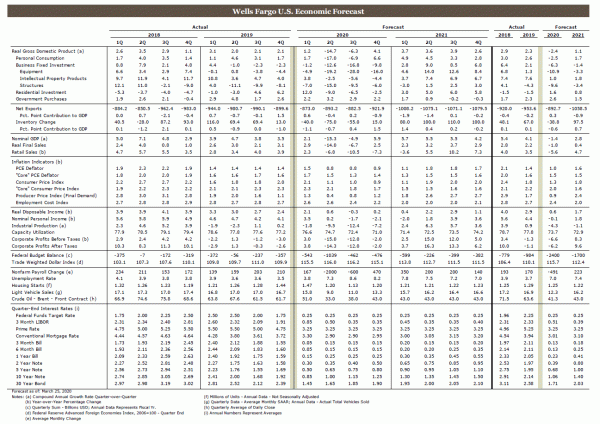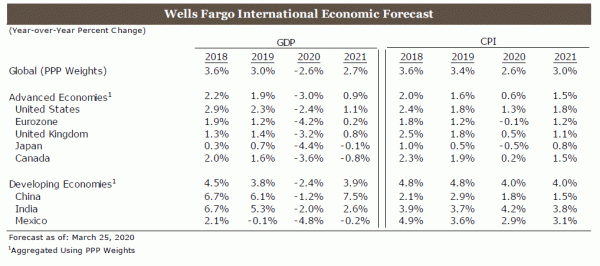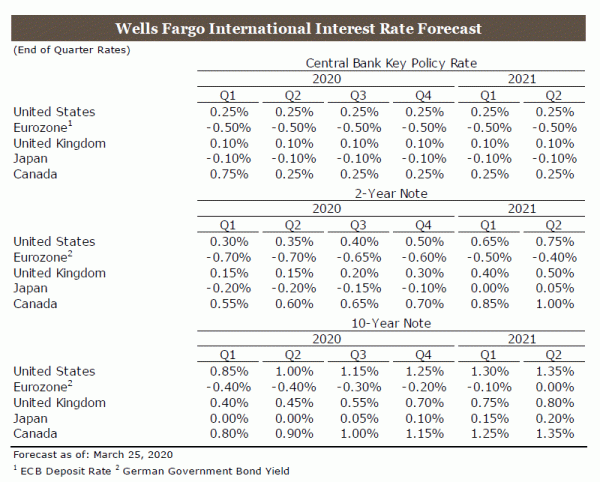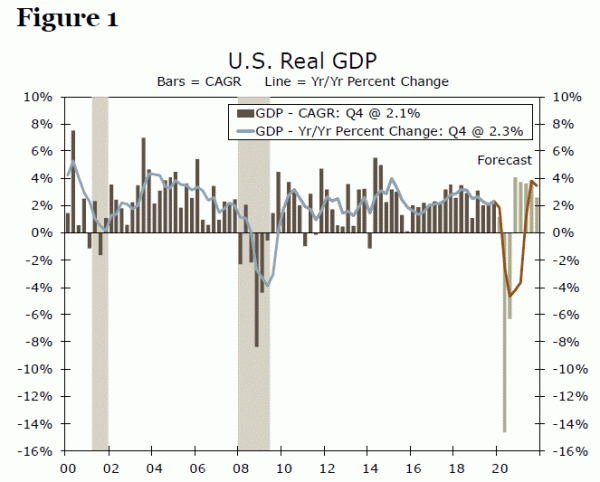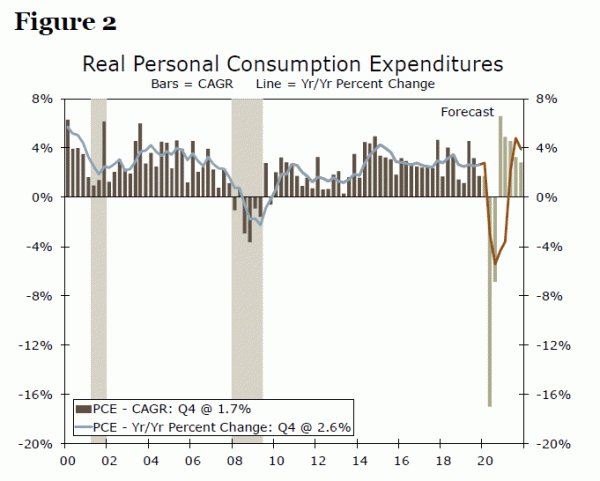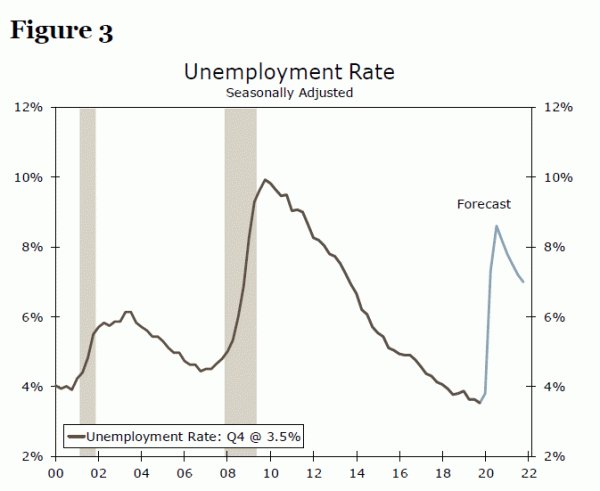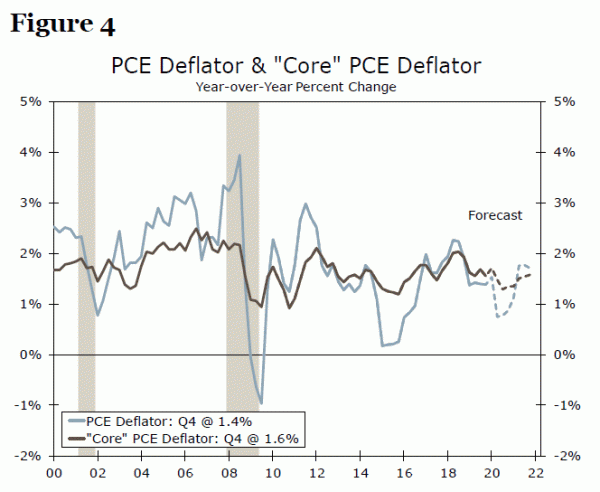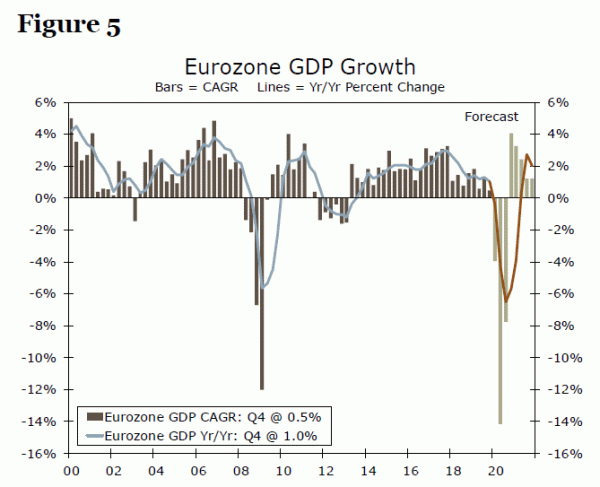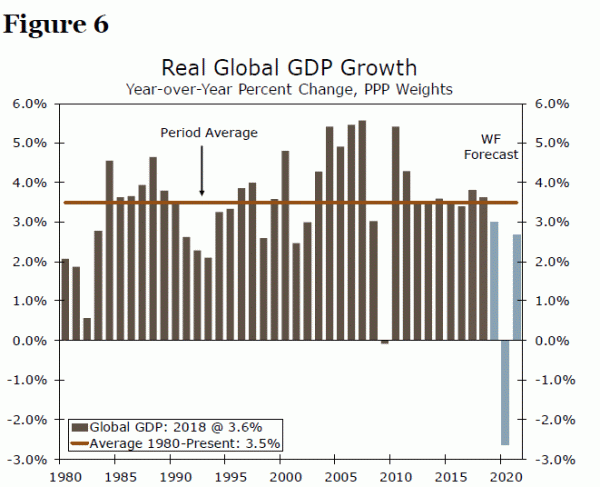Executive Summary
The rapidly evolving COVID-19 outbreak and the steps that authorities around the world have taken to combat it have caused us to rethink the forecast that we released only last week. We now look for the U.S. economy to contract more than 5% (not annualized) over the next two quarters, making it the deepest peak-to-trough decline in real GDP in the post-World War II era. However, the Federal Reserve has recently undertaken a number of measures to keep credit flowing to businesses and households, and it appears that Congress will soon approve meaningful fiscal measures that should cushion some of the blow to the economy. Assuming that the virus does not come roaring back again this autumn, then the economy should begin to recover later this year. Globally, we now forecast that real GDP will decline more than 2% in 2020, which also would be a record-setting contraction on a worldwide basis. Clearly, the situation remains very fluid, and we stand ready to make further near-term adjustments to our forecast, if needed.
U.S. Economic Outlook
In the forecast update that we published only a week ago, we looked for a two-quarter contraction in U.S. real GDP with a peak-to-trough decline that totaled 1.4%. However, the risks to that forecast now appear to be skewed significantly to the downside due to subsequent developments related to the rapidly evolving COVID-19 pandemic. There were less than 5,000 confirmed cases of COVID-19 in the United States at the beginning of last week. That number today exceeds 55,000, and it undoubtedly will shoot much higher in coming days and weeks. Moreover, the number of states and municipalities that have enacted some form of lockdown continues to grow.
Consequently, we have revised our forecast and now look for a much deeper contraction in the U.S. economy. Specifically, we are projecting that real GDP in the United States will nosedive at an annualized rate of roughly 15% in Q2-2020, which would make it the sharpest rate of decline in the 73-year history of quarterly GDP data (Figure 1). Adding in the contraction that we project will occur in the third quarter produces a peak-to-trough decline in U.S. real GDP that totals more than 5%, which would be the deepest downturn in the U.S. economy in the post-World War II era.1
But we look for the U.S. economy to start bouncing back later this year, which would make it different from most other recessions that have occurred since the end of the Second World War. As we noted in our forecast update last week, the economy built up few major imbalances during the recently ended 10-year long expansion, so the economy should return to a positive trajectory once the COVID-19 pandemic is brought under control. Of course, that forecast is predicated on the assumption that the outbreak is indeed brought under control, and that it does not come roaring back later this year. Furthermore, some of the steps that policymakers have taken recently—more on this subsequently—should help to cushion some of the blow to the economy.
The severity of the contraction that we forecast for overall GDP reflects the swoon in real personal consumption expenditures (PCE), which accounts for roughly two-thirds of overall spending in the economy. There are some categories of consumer spending, such as air travel, restaurants, hotels, etc., that have more or less experienced “sudden stops.” Not only will sharp declines in spending in these categories directly depress PCE, but there will be indirect negative effects on other categories of spending as newly unemployed workers slash discretionary consumption. On the other hand, some categories (e.g., spending on groceries and health care products) will be boosted. On net, however, overall PCE should tumble markedly (Figure 2).
But the policy measures that have been put in place should provide some support. For starters, the Federal Reserve has taken steps to keep credit flowing to businesses and households. Specifically, the Fed is providing much needed liquidity to markets in corporate bonds and asset-backed securities, and it will soon announce details about a facility that is designed to support lending to small- and medium-sized businesses. In addition, Congress appears ready to approve legislation that will, among other things, increase funding for unemployment insurance and give tax rebates to individuals and families. In addition, the legislation will provide generous financing to businesses so that the hit to economy-wide spending that is underway does not force them into bankruptcy, thereby exacerbating the downturn.
We project that nonfarm payrolls will decline by roughly eight million jobs over the next two quarters and that the unemployment rate will shoot up from its current 50-year low of 3.5% to nearly 9% in the third quarter of this year (Figure 3). The slump in economic activity and the sharp rise in the unemployment rate should push consumer price inflation (as measured by the year-overyear change in the PCE deflator) down to less than 1% by this summer (Figure 4). Consequently, the Federal Open Market Committee likely will keep its target range for the fed funds rate between 0.00% and 0.25% indefinitely.
The events of the past few weeks have been unprecedented, and we have no useful roadmap to follow that would give us clear insights into how the economy may evolve in coming quarters. So there is a considerable amount of uncertainty that surrounds the specific numbers in the forecast table on Page 5. In general, however, we think that a record-setting rate of economic contraction in the second quarter is essentially a foregone conclusion, and we look for the growth-depressing after-effects of the shock to linger through the third quarter. The ranks of the unemployed likely will swell dramatically in coming months. But we look for the economy to begin recovering later this year, assuming that the outbreak does not reappear.
But could our revised outlook still be too sanguine? Could the U.S. economy be on the cusp of another Great Depression? Perhaps, but we do not believe that is the most likely outcome. There was an economic downturn underway in 1929-1930 that then turned into the Great Depression due to an utter failure of policy. The banking system collapsed in the early 1930s due to inaction by the Federal Reserve and other authorities, and fiscal policy did not turn expansionary until more than three years into the downturn.
Fast forward 90 years. As we wrote in a recent report, the banking system is very well capitalized at present, and the Federal Reserve recently announced a number of unprecedented measures to support the nation’s credit markets. Fiscal policy has turned expansionary. Assuming that the steps taken to arrest the COVID-19 pandemic do not last indefinitely, we think there is enough policy support in place or soon to be enacted to prevent the deep recession that is now underway from turning into a deeper and more prolonged economic depression. Moreover, we are reasonably confident that policymakers would take further steps, if needed, to prevent another 1930s-like economic disaster from occurring.
Global Economic Outlook
In our March 16 update we forecasted that global GDP would grow roughly 1% in 2020. Although this deceleration would not be as serious as the modest contraction that occurred in global GDP in 2009, it would be a more abrupt downshift than the slowdowns that occurred in the early 1990s and again after the tech bubble collapsed in 2000. But like our previous forecast for the U.S. economy, it now appears that our forecast of global GDP growth was too optimistic. Due to the marked acceleration in COVID-19 cases and steps that foreign authorities have taken in recent days to combat it, we now are looking at a deeper downturn in global economic activity.
Let’s start with the Eurozone. We now forecast that real GDP in the Eurozone will slump at an annualized rate of roughly 15% in the second quarter, surpassing the rate of contraction that was registered during the darkest days of the financial crisis (Figure 5). Many countries in the euro area are essentially locked down at present, so many parts of those economies have come to an abrupt halt. But under the assumption that the social distancing measures that have been put in place succeed in bringing the outbreak in Europe to an end, then economic activity in the Eurozone should begin to stabilize later this year. Still, we look for real GDP in the euro area to fall about 4% this year (see Page 6). The United Kingdom is also locked down at present, and we forecast that the U.K. economy will contract 3% in 2020.
Since at least 1980, China has never experienced a year in which real GDP has contracted. We believe that string will come to an end in 2020 as we forecast that Chinese GDP will fall about 1% this year. Much of this contraction in 2020 reflects the nosedive that the economy experienced earlier this year when some of the most economically important regions of the country were under complete lock down. Now that life is returning to normal in China, the economy should bounce back. Still, it will take a few quarters to dig out of the deep hole the economy fell into during Q1. Moreover, deep recessions in most other major economies will exert some headwinds on Chinese GDP growth this year via weaker export growth.
The Japanese economy entered 2020 on an anemic note due, at least in part, to the one-two punch of the hike in the consumption tax and a devastating typhoon that both occurred in October. The economic effects of the COVID-19 pandemic have imparted another serious shock to the Japanese economy, and we forecast that real GDP in Japan will tumble more than 4% this year, the worst performance since 2009. The United States is the most important trading partner for both Canada and Mexico, and we expect that economic weakness in the United States this year will contribute to the significant contractions that we forecast in 2020 for both the Canadian and Mexican economies.
Summing it all up, we now forecast that global GDP will tumble more than 2% in 2020, the deepest global downturn in at least 40 years (Figure 6). Under the assumption that the pandemic does not return to the northern hemisphere later this year, we look for growth in most economies to turn positive again by the end of 2020. Still the 2.7% growth rate that we forecast for global GDP in 2021 would still be markedly below the 3.5% per annum growth rate that the global economy has averaged over the past 40 years 